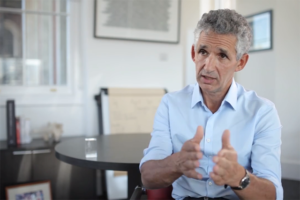Biomarkers of Aging
Biologist Tim Spector on the different ways of assessing biological age, twin studies, and the microbiome
A century ago 1917 famous British mathematician biologist D’Arcy Thompson published a book called “On Growth and Form”, where he presented a number of interesting ideas, which are still quite relevant to us today. One of them is the theory of transformations, where he applied mathematical models and mathematical thinking to connect biological shapes of living organisms to each other. When he took biological shapes of existing species, of crabs, and other animals and plants, and he showed that by geometrically transforming them you could connect them in logical ways, which was very interesting, because he showed that the shapes, biological shapes are not random, they are connected by mathematical logic, which to him meant the underlying physical and genetic principles that generated them.
There is a very simple mathematical principle that he applied. In fact, he borrowed this principle from a German artist and scientist from a century before called Durrell, who used drawings, and he used point for point transformations to show the relationship. One of the most famous examples D’Arcy Thompson used is a head shape of the early horse ancestor, Hyperion. He transformed it via shapes of intermediate species into the shape of a skull of a modern horse. This is one of the most powerful examples of our transformation that essentially betrays evolution, from a primitive shape onto the modern form, onto the modern species.
We’re still using these transformations today. We call it geometric morphometrics, where we use two landmarks, and sometimes – landmarkless approaches. The main goal here is to understand how the biological shapes are related to each other. In our own work, we use this approach to understand how shapes of Darwin’s finches, for example, evolved over time, where we applied so-called affine transformations, the very transformations that D’Arcy Thompson used to see if they can be used to explain evolution Darwin’s finches big shapes.
We found that this 2 transformation scaling is here again. The very transformations that D’Arcy Thompson used could successfully explain the entire variation of very highly adapted big shapes in Darwin’s finches. During the time of Thompson, which was in early 20th century it was quite this idea that you can connect biological shapes to each other using geometry, using mathematics was very new and very striking. It took some time for the scientists to realized that this ideology could be applied more broadly than just took a few chosen examples. For the most of the 20th century, this new field of what we call now geometric morphometrics was very slowly developing with more and more interesting and useful methods introduced by scientists.
For example, one of the key innovations was using landmarks and placed on what we call homologous points. That is the same points on the animal or plants, which are evolutionarily related, if you place landmarks on them, then you can connect these landmarks into what we call a wireframe structure, and then see how this outline of the biologic object changes over time. Another breakthrough was that we can use zero transformations to understand how biological shape changes during individual development, from an embryo to all the way to adults, through juvenile stages. The fact that one can seamlessly connect biological shapes through developments will often be informative also to think about what happened you in evolution is a very powerful approach by itself. In the more recent times, the last 20-30 years, geometric morphometrics – when we used both evolutionary source of data, but also developmental from the same species -has given us new insights into how evolution proceeded or how to interpret developmental data more accurately.
Geometric morphometrics, the field, which was established by D’Arcy Thompson, is incredibly important part of science today. We use geometric morphometrics to understand how biological shaped changes, for example, from normal to abnormal in medicine. When we look at the shapes of skulls and other bones in humans in normal conditions, but also in some of the abnormal conditions that can be a very powerful way to understand what happened during disease.
In our own work, we were able to use geometric morphometrics with landmarks placed on skulls of multiple species of archosaurs – these are animals related to birds and crocodilians – to understand how their skull shapes changes. Their skull shape changed during evolutionary time. By adding skull shapes from juveniles embryos were able to show that the origin of birds from reptiles, from these dinosaurs, which look more like reptiles, can be best explained by a process called metamorphism, where the descendants have the juvenile shapes of their ancestors. That is the first birds, such as Archaeopteryx, their skull shape geometrically defined by the skull shape of first birds is very similar to the skull shapes of the juvenile non-avian dinosaur ancestors.
This was all done within the same morphometric space. We used the same landmarks, replaced them on the same positions within the skulls of the species absenting the entire lineage of archosaurs, from early archosaurs through dinosaurs all the way to modern birds. When we combined all this data in the computer within the same morphometric space, it was very clear that modern birds and first birds were in what we call the baby space, that is the part of the morphometric space, which is occupied by heaps of embryos and juveniles of the non-avian dinosaurs, which had much more reptilian appearance.
Geometric morphometrics made a huge amount of progress in the last 100 years since Thompson. For example, we’re very actively moving from two-dimensional morphometry, where we look at the outline of the skull in 2D or outline of political bone or, for example, in 2D towards more three-dimensional or even four-dimensional morphometry, where we look at the computer tomography scans, we used X-rays to generate high-definition 3-dimensional images of skulls of reptiles and mammals. We place landmarks both externally on various external landmarks, but also internally that way we can understand how the shape of these biological object changes in its full complexity in three dimensions. We can also look at the evolution in the development of internal structures, for example. We can look at the changes in the developing brain. We can look at the changes in the developing our factory structures, the eyes, and see how these different internal and external parts are integrated, and how they change during evolution and development together.

Biologist Tim Spector on the different ways of assessing biological age, twin studies, and the microbiome

Bioinformatician Manja Marz on non-coding RNAs, the dynamic programming approach, and homology search

Neuroeconomist Sacha Bourgeois-Gironde on the symbolic aspect of money, brain processing of economic artifacts...